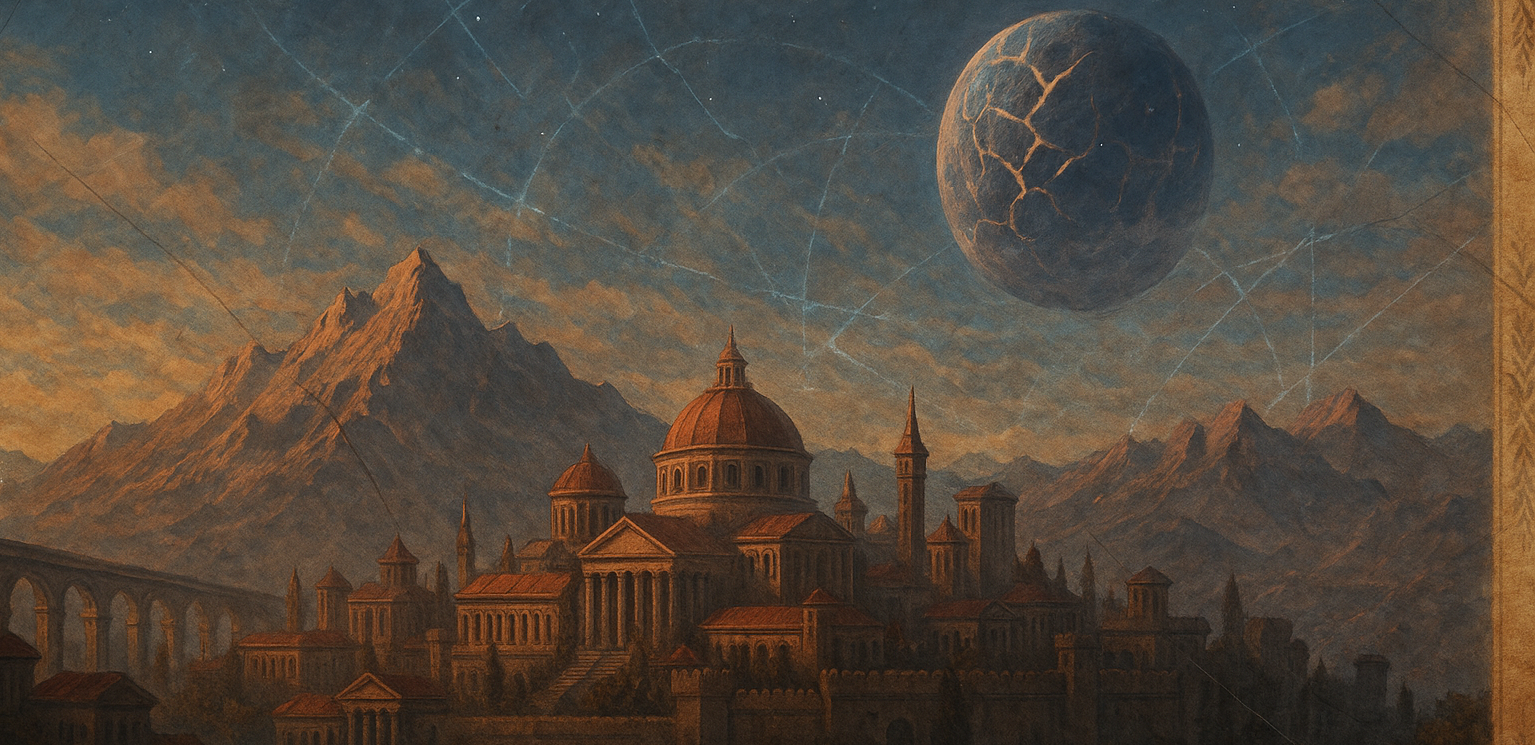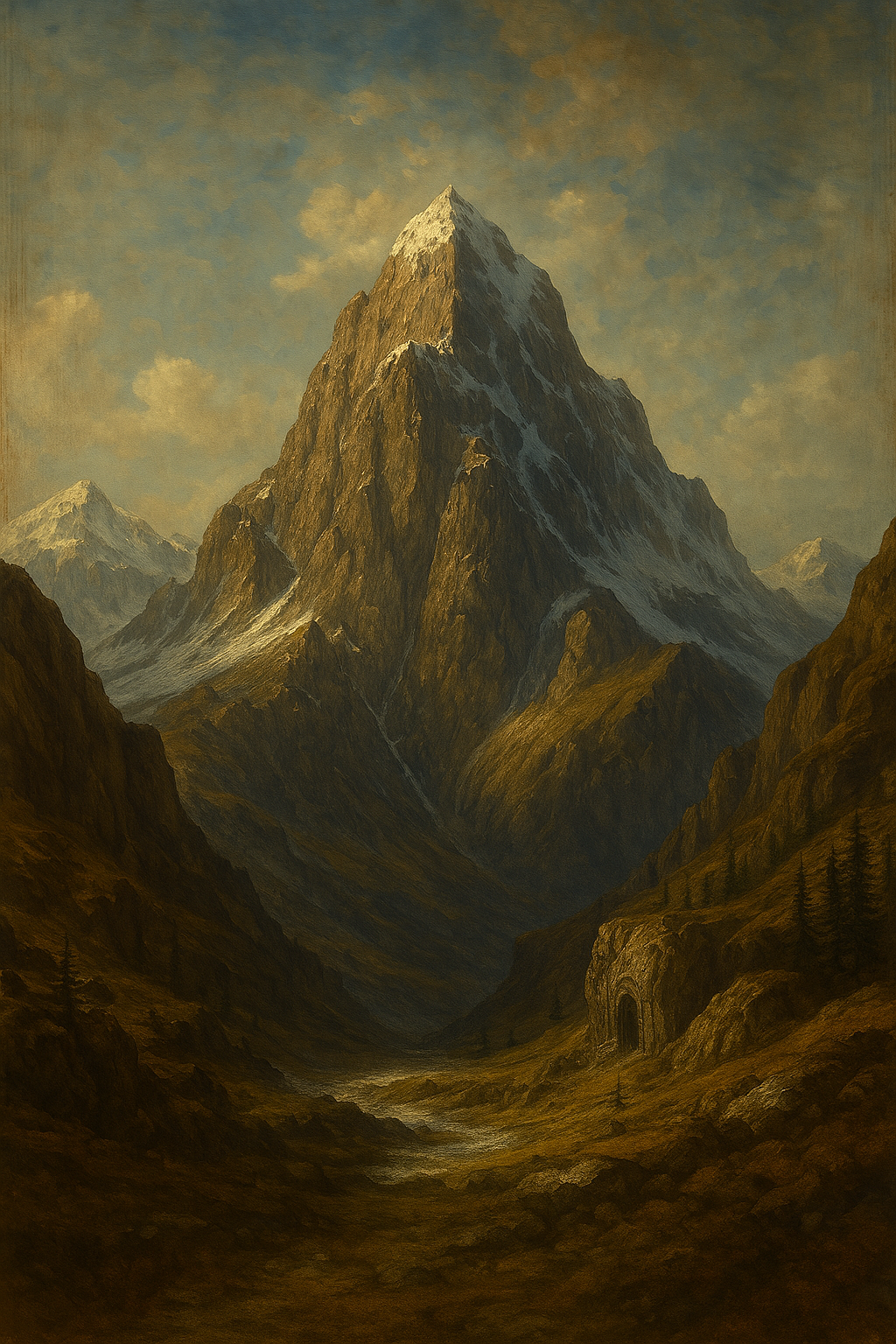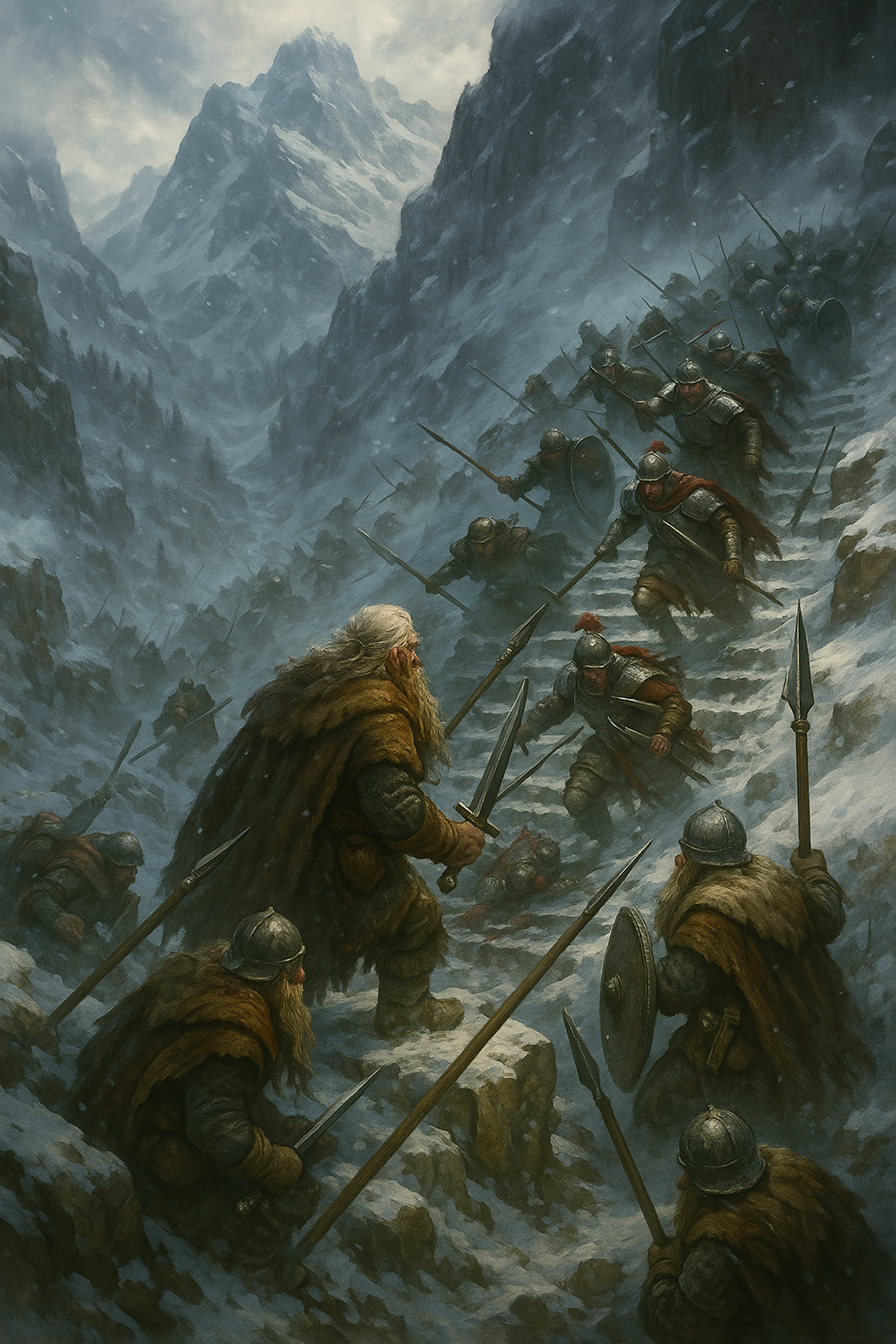Mount Targaleth
“Here the mountains stood, and here we stood with them.”
Mount Targaleth rises like the keystone of the Ashfang Range, its crown perpetually veiled in snow and cloud. To the dwarves, it is more than a mountain — it is a testament to their endurance and a silent witness to their covenant of freedom. Its sheer cliffs glint with veins of silver and ice, and its upper reaches are said to hold the whispers of every oath sworn beneath its shadow. It is here, at the summit’s Concord Stone, that the dwarves and the Empire forged the treaty which has kept their people sovereign for centuries. Every crevice of the mountain seems to hum with the quiet weight of history, as though the stone itself remembers.
Geography
The mountain’s lower slopes are carved into terraced fields and fortified hamlets, dotted with watchtowers and narrow bridges that span dizzying gorges. These give way to jagged granite walls and knife-edged ridges climbing toward a glacial plateau, from which the final ascent winds upward through perilous switchbacks and hidden stairways, some no wider than a shield’s breadth. Caves riddle the flanks of Targaleth, glowing faintly with crystals and bioluminescent moss, while a glacier-fed lake at its base shimmers with impossibly clear, icy water. At the summit stands the famed Concord Stone — an immense flat slab, polished smooth and carved with the names of the dwarves’ founding clans and the terms of the accord.
Ecosystem
Life clings stubbornly to the mountain. Alpine meadows bloom briefly with wildflowers and resilient grasses before giving way to moss-covered scree higher up. Hardy goats and marmots scramble across the cliffs while snow hawks wheel overhead, nesting in narrow ledges. Deep within the caves, strange blind fish dart in subterranean streams, and colonies of luminous fungi create eerie, glowing gardens of stone. At night, the stars above seem close enough to touch, and the wind carries the scents of pine, cold stone, and faint iron.
Ecosystem Cycles
Targaleth’s seasons are as stern as the dwarves themselves. Spring awakens the valleys in a roar of meltwater, sending cascades of white down into the lake, while avalanches clear the higher slopes of winter’s weight. Summer is brief but lush in the lower meadows, where goats and wildflowers thrive before retreating at the first touch of frost. Autumn brings mists that coil through the passes like serpents, and in winter the entire mountain is swallowed in silence and snow, its paths closed to all but the hardiest.
Localized Phenomena
The mountain is famed for its Echo Storms — sudden, roaring winds that whip through the passes and caverns, producing haunting harmonies that seem to carry the voices of ancestors. Occasionally, when the Rift’s power flares elsewhere in the world, the peak glows faintly under strange shimmering lights that dance along the snowfields — an event the dwarves call The Veil of Stone. In some rare years, the glacier seems to ‘sing’ — groaning and cracking in tones so deep they can be felt in the chest.
Climate
The climate of Mount Targaleth is harsh and capricious, even at its best. The lower slopes enjoy brief, cool summers and tolerable winters, but above the treeline the air grows thin, frigid, and biting. Sudden storms can cloak the mountain in sheets of ice within hours, and climbers speak of gusts that can tear the breath from one’s lungs. Even in summer, snow persists on the upper ridges, and the wind never truly falls silent.
Fauna & Flora
Life on Targaleth is sparse yet resilient. Alpine pines and blood-lilies take root in rocky crevices, while moss and lichen cling to shaded stones. Wild goats, their horns like polished ivory, navigate impossibly steep slopes. Marmots whistle warnings from boulder-strewn meadows, while snow leopards hunt silently among the drifts. Higher up, hawks and black ravens circle the peaks, and in the hidden caves below, pale fish flicker and vanish into underground streams, and delicate fungi light the darkness with their glow.
Natural Resources
Beneath Targaleth’s forbidding beauty lies wealth: veins of silver that glint like moonlight in the rock, iron as strong and unyielding as the people who mine it, and veins of marble marbled with streaks of black and gold. Precious gems have been pried from its heart — sapphires, garnets, and smoky quartz — though the dwarves take care to mine respectfully, lest they provoke the mountain’s wrath. Near the Concord Stone, no pick or hammer strikes the rock, for that ground is considered sacred.
History
The history of Mount Targaleth is inseparable from the story of the dwarves themselves — a saga carved into the stone as much as the mountain itself.
In the earliest chronicles, the peak was known simply as Kar Thargrim — “the Stone that Stood” — a revered landmark where the first dwarven clans gathered to honor their ancestors and resolve disputes under the unblinking gaze of the sun and stars. Long before Imperial banners ever crested its ridges, Targaleth had already witnessed countless rites, feasts, and funerals, its caves echoing with chants and its snow stained by more than one feud among the clans.
When the Empire came, it came with fire and iron, marching into the Ashfang Range with the arrogance of conquerors who believed no peak could resist them. At first, the legions seized the lower valleys easily, scattering villages and toppling watchtowers. But the deeper they pushed, the harder the dwarves’ resistance became, until the slopes of Targaleth themselves ran red with Imperial blood. For decades the fighting dragged on — brutal sieges of the mountain’s lower halls, sabotage of supply lines, avalanches loosed by dwarves upon the invaders.
The turning point came during the infamous Winter of Spears. The Imperial High General led his forces in a final campaign to seize the summit, believing that breaking the dwarves at their spiritual heart would end the war. But he underestimated the mountain. His troops were ambushed on the ice-clad stairways, driven into the ravines, and buried under avalanches by warriors who knew every crack and ledge. Cut off, starving, and decimated by the cold, the High General was forced to parley.
It was on the windswept summit, before the Concord Stone, that the dwarves dictated their terms — not with pen and parchment, but with hammer and chisel. There, before witnesses on both sides, the Free Concord of Targaleth was etched into the rock: a pact guaranteeing dwarven autonomy, the sanctity of their ancestral lands, and trade in exchange for dwarven aid should the Empire face an existential threat.
Since that day, Mount Targaleth has remained inviolate — a place of pilgrimage for dwarves and, reluctantly, for Imperial envoys. Every major oath of office among the Stone Assembly is sworn before the Concord Stone, and it is said the mountain remembers every word.
In times of peace, the mountain has been a place of solemn ceremony and quiet pride. In times of war, it has again become a fortress — its watchtowers blazing with signal fires, its hidden stairs echoing with the tread of boots and the clash of shields.
To the dwarves, Mount Targaleth is not just where they earned their freedom. It is where they proved — to the Empire, to the gods, and to themselves — that they were as unyielding as the stone they came from.
Tourism
For those few outsiders permitted beyond the dwarves’ guarded gates, Mount Targaleth is both awe-inspiring and humbling. Scholars climb its paths to study the Concord Stone and hear the Echo Storms firsthand. Pilgrims make the arduous journey to lay hands on the Stone and swear their own oaths upon it. Traders marvel at the hanging bridges, hidden halls, and the craftsmanship of the watchtowers. But the journey is not for the faint of heart — accommodations are sparse, the air is thin, and the dwarves do not suffer fools lightly.





Comments